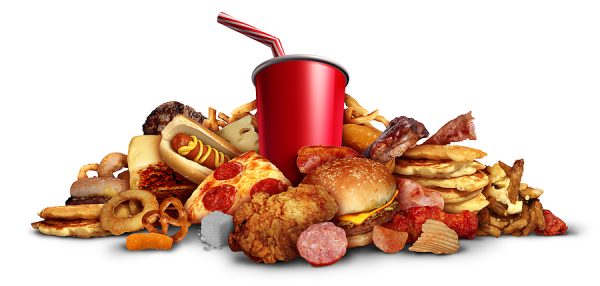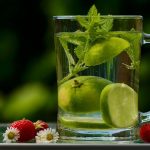Up to 80 percent of all strokes can be prevented with basic lifestyle changes. In sheer numbers, this means four out of every five strokes could be averted.
Five of the best things you can do to protect against a stroke are to be a non-smoker, eat a healthy diet, participate in regular physical activity, maintain a healthy weight and keep your blood pressure in check.
While smoking is a challenge you have to take up on your own. The others have a way of working themselves out.
It’s as simple as this. If you eat a healthy diet… and if you get in a good workout on a regular basis… a healthy weight and healthy blood pressure will follow.
When I explain this to my patients, they get it. They understand what they have to do, up until the point when it comes to deciding which foods will help prevent a stroke, and which could promote a traumatic event.
So let me break it down for you…
3 Foods that Contribute to Stroke
If you plan on getting through your lifetime without ever experiencing a stroke, you need to be aware that there are three types of food that can seriously derail your efforts.
The first is foods that are high in sodium. They can lead to a stroke, high blood pressure and heart disease. The current recommendation is to consume less than 2,300 mg of sodium daily if you are in good health. But guidelines are quickly moving toward no more than 1,500 mg per day.
Still, Americans eat, on average, about 3,400 mg of sodium each day. And nearly 100% of the population exceeds the healthier limit of 1,500 daily.
Personally, I recommend slashing sodium intake to less than 1,000 mg daily. Read the nutrition panels on your food labels, and make sure to check the sodium per serving against the recommended serving size to choose low-sodium foods.
The second is refined carbohydrates and sugars that have a high glycemic load (GL). These foods increase your stroke risk by nearly 20%.
If you’re not familiar with the term, GL measures the quality of a carbohydrate in a given food and estimates how much it will raise blood sugar levels after eating it. A GL greater than 20 is considered high.
It can be a better measure than the glycemic index (GI) because it measures both the amount and quality of carbohydrates a food contains, and the amount you would be expected to eat. (The GI index only measures how quickly a carb will cause your blood sugar to rise.)
You can find a lot of GI and GL charts on the internet, but most are selective in the foods they choose. I like this one, because it is very inclusive.
The third is red and processed meats. Red meat, especially processed red meat, raises blood pressure and increases your risk of stroke. I always recommend enjoying small amounts of grass-fed meat in your diet and limiting intake of other meats to those few occasions when you can’t avoid them.
This is a surprisingly short list. And if you are vigilant, it’s not hard to avoid these foods.
On the other hand, there are plenty of stroke defeating foods that you can enjoy every single day.
6 Foods that Protect Against Stroke
Fruits and vegetables count for a lot. A BIG LOT! For every seven ounces of fruit you eat each day your stroke risk is decreased by about 32%. And for every seven ounces of veggies, it’s reduced by 11%.
Get fishy for stroke prevention. Eating five or more servings of fresh, wild-caught fish each week lowers stroke risk. The omega-3 fatty acids found in fish provide arterial protection that prevents the plaque build-up that can block blood flow to the brain.
Drink three cups of tea each day. People who drink three or more cups of tea daily cut their chances of stroke, including cerebral infarction and intracerebral hemorrhage, by 15% to 20%.
Indulge your chocolate cravings. The flavonoids in dark chocolate can help lower your risk of stroke by enhancing blood flow, lowering blood pressure and reducing inflammation. For best results, choose a high-quality dark chocolate that contains about 70% cacao and stick to no more than 3.5 ounces a week (.5 ounces daily).
Eat more potassium rich foods. Potassium balances out the negative effects of sodium, and getting just 3,500 mg of this mineral daily is associated with the lowest risk of stroke. Avocado, cantaloupe, artichoke, mangoes and pears are all good sources of potassium.
Go nuts for nuts. People who eat the most tree nuts tend to have lower odds of suffering a stroke – and early death from stroke – than those who eat the least. Brazil nuts, walnuts, pecans, pistachios and other tree nuts all have a positive effect on your cardiovascular system, which is responsible for pumping blood to your brain.
In the meantime, it is critical that you know the signs of a stroke since any delay in treatment can lead to permanent damage. So remember the FAST acronym that you can use to determine the warning signs of a stroke. This stands for…
- Facial drooping
- Arm weakness
- Speech difficulty
- Time to call 911
If you need help identifying these symptoms, there are some simple ways to check them.
A smile will quickly show if your face is drooping, because one side of your mouth will be unable to execute the smile. Raising both arms over your head will reveal any arm weakness, and trying to speak a full and coherent sentence can determine any speech difficulties.
For an extremely quick check of symptoms, try raising your arms while sticking out your tongue.
If you or someone you know experiences difficulty with any single one of these tasks, it’s time to call 911 without delay!
SOURCES:
Rutten-Jacobs L C, Larsson S C, Malik R, Rannikmäe K, et al. Genetic risk, incident stroke, and the benefits of adhering to a healthy lifestyle: cohort study of 306 473 UK Biobank Participants. BMJ 2018; 363 :k4168.
Aburto NJ, Ziolkovska A, Hooper L, et al. Effect of lower sodium intake on health: systematic review and meta-analyses. BMJ. 2013 Apr 3;346:f1326.
Fan J, Song Y, Wang Y, Hui R, Zhang W. Dietary glycemic index, glycemic load, and risk of coronary heart disease, stroke, and stroke mortality: a systematic review with meta-analysis. PLoS One. 2012;7(12):e52182.
Yang C, Pan L, Sun C, Xi Y, Wang L, Li D. Red Meat Consumption and the Risk of Stroke: A Dose-Response Meta-analysis of Prospective Cohort Studies. J Stroke Cerebrovasc Dis. 2016 May;25(5):1177-1186.
Hu D, Huang J, Wang Y, Zhang D, Qu Y. Fruits and vegetables consumption and risk of stroke: a meta-analysis of prospective cohort studies. Stroke. 2014 Jun;45(6):1613-9.
Chowdhury R, Stevens S, Gorman D, et al. Association between fish consumption, long chain omega 3 fatty acids, and risk of cerebrovascular disease: systematic review and meta-analysis. BMJ. 2012 Oct 30;345:e6698.
Saber H, Yakoob MY, Shi P, Longstreth WT Jr, Lemaitre RN, Siscovick D, Rexrode KM, Willett WC, Mozaffarian D. Omega-3 fatty acids and incident ischemic stroke and its atherothrombotic and cardioembolic subtypes in 3 US cohorts. Stroke. 2017 Oct; 48(10): 2678–2685.
Zhang C, Qin YY, Wei X, Yu FF, Zhou YH, He J. Tea consumption and risk of cardiovascular outcomes and total mortality: a systematic review and meta-analysis of prospective observational studies. Eur J Epidemiol. 2015 Feb;30(2):103-13.
Kwok CS, Boekholdt SM, Lentjes MA, Loke YK, Luben RN, Yeong JK, Wareham NJ, Myint PK, Khaw KT. Habitual chocolate consumption and risk of cardiovascular disease among healthy men and women. Heart. 2015 Aug; 101(16): 1279–1287.
Vinceti M, Filippini T, Crippa A, de Sesmaisons A, Wise LA, Orsini N. Meta-Analysis of Potassium Intake and the Risk of Stroke. J Am Heart Assoc. 2016 Oct 6;5(10). pii: e004210. Ivey KL, Nguyen XT, Quaden RM, Ho YL, Cho K, Gaziano JM, Djoussé L. Nut consumption and risk of stroke. Eur J Epidemiol. 2015 Mar;30(3):189-96.



